INSTITUT SUPERIEUR D'ANTHROPOLOGIE
INSTITUTE OF ANTHROPOLOGY
ONLINE COURSES / COURS A DISTANCE
SPRING SESSION : APRIL 2013
REGISTER NOW
INDE – 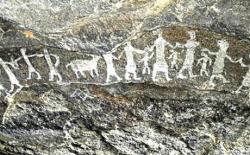 Palani - Paintings that are over 3,000 years old, belonging to the Sangam period, showcasing the love and valour of Tamils, were discovered in the Andipatti hills near here on Sunday. V Narayanamorthy, Secretary of the Tamil Nadu Archaeological Research Institute, and his team came upon the paintings when they were inspecting some caves, west of Andipatti hills. He said, “The faded paintings have been found in over 10 places in the cave and were painted in white colour using a mixture of limestone, natural gums and herbal extracts.” One of the paintings shows a group of women carrying pots of water on their heads, while another shows men, women and children dancing together at a festival, holding hands. What’s interesting is that this kind of dance can still be seen in the Paliyar and Puliyar tribal communities, the archaeologists said. Another picture shows people getting ready to sacrifice a goat for a festival. The paintings also tell stories—one of an elephant captured and trained, on which the king goes for a ride surrounded by guards. Several scattered paintings depict men, women and tigers and hunts undertaken. The caves were in frequent use about 2,000 to 3,000 years ago.
Palani - Paintings that are over 3,000 years old, belonging to the Sangam period, showcasing the love and valour of Tamils, were discovered in the Andipatti hills near here on Sunday. V Narayanamorthy, Secretary of the Tamil Nadu Archaeological Research Institute, and his team came upon the paintings when they were inspecting some caves, west of Andipatti hills. He said, “The faded paintings have been found in over 10 places in the cave and were painted in white colour using a mixture of limestone, natural gums and herbal extracts.” One of the paintings shows a group of women carrying pots of water on their heads, while another shows men, women and children dancing together at a festival, holding hands. What’s interesting is that this kind of dance can still be seen in the Paliyar and Puliyar tribal communities, the archaeologists said. Another picture shows people getting ready to sacrifice a goat for a festival. The paintings also tell stories—one of an elephant captured and trained, on which the king goes for a ride surrounded by guards. Several scattered paintings depict men, women and tigers and hunts undertaken. The caves were in frequent use about 2,000 to 3,000 years ago.
http://newindianexpress.com/states/tamil_nadu/article1487346.ece
USA – 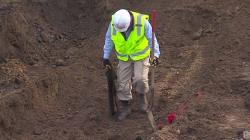 Charleston - Friday proved to be another fascinating day of discovery at the Gaillard Auditorium construction site. Archaeologists found coins they believe date back to the late 1600s or early 1700s. So far, archaeologists have unearthed 37 graves that may date back to the colonial days of the city. Eric Poplin, the lead archaeologist, said Friday the coins were found near the remains of an adult and a child. "It's very interesting," said Poplin. "If the date of the burials is what we think they are -- the early 18th century -- it would be the earliest group of people that anyone's had the opportunity to look at here in Charleston." One of the coins was found near a head and the other was found near where an eye socket, Poplin said. Poplin said there should be four coins total, but they have not found the other two yet. He said it was common practice in the 18th century to bury the dead with coins. "The coins themselves, we can't tell what they are. They're too corroded at this point, but later on we'll do some analysis, clean them up and we might be able to get some information off them," Poplin said.
Charleston - Friday proved to be another fascinating day of discovery at the Gaillard Auditorium construction site. Archaeologists found coins they believe date back to the late 1600s or early 1700s. So far, archaeologists have unearthed 37 graves that may date back to the colonial days of the city. Eric Poplin, the lead archaeologist, said Friday the coins were found near the remains of an adult and a child. "It's very interesting," said Poplin. "If the date of the burials is what we think they are -- the early 18th century -- it would be the earliest group of people that anyone's had the opportunity to look at here in Charleston." One of the coins was found near a head and the other was found near where an eye socket, Poplin said. Poplin said there should be four coins total, but they have not found the other two yet. He said it was common practice in the 18th century to bury the dead with coins. "The coins themselves, we can't tell what they are. They're too corroded at this point, but later on we'll do some analysis, clean them up and we might be able to get some information off them," Poplin said.
http://www.abcnews4.com/story/21439625/archaeologist-bodies-may-be-earliest-remains-found-in-charleston
ITALIE – 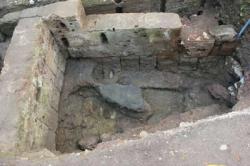 Rome - The temple built by Romulus to celebrate the hand of Jupiter giving Roman troops their unstoppable force has been found at the foot of the Palatine Hill, Italian archaeologists say. The ruins of the shrine to Jupiter Stator (Jupiter the Stayer), believed to date to 750 BC, were found by a Rome University team led by Andrea Carandini. "We believe this is the temple that legend says Romulus erected to the king of the gods after the Romans held their ground against the furious Sabines fighting to get their women back after the famous Rape (abduction)," Carandini said in the Archeologia Viva (Living Archaeology) journal. According to myth, Romulus founded Rome in 753 BC and the wifeless first generation of Roman men raided nearby Sabine tribes for their womenfolk, an event that has been illustrated in art down the centuries. Carandini added: "It is also noteworthy that the temple appears to be shoring up the Palatine, as if in defence". Rome's great and good including imperial families lived on the Palatine, overlooking the Forum. Long after its legendary institution by Romulus, the cult of Jupiter the Stayer fuelled Roman troops in battle, forging the irresistible military might that conquered most of the ancient known world. In the article in Archeologia Viva, Carandini's team said they might also have discovered the ruins of the last Palatine house Julius Caesar lived in - the one he left on the Ides of March, 44BC, on his way to death in the Senate.
Rome - The temple built by Romulus to celebrate the hand of Jupiter giving Roman troops their unstoppable force has been found at the foot of the Palatine Hill, Italian archaeologists say. The ruins of the shrine to Jupiter Stator (Jupiter the Stayer), believed to date to 750 BC, were found by a Rome University team led by Andrea Carandini. "We believe this is the temple that legend says Romulus erected to the king of the gods after the Romans held their ground against the furious Sabines fighting to get their women back after the famous Rape (abduction)," Carandini said in the Archeologia Viva (Living Archaeology) journal. According to myth, Romulus founded Rome in 753 BC and the wifeless first generation of Roman men raided nearby Sabine tribes for their womenfolk, an event that has been illustrated in art down the centuries. Carandini added: "It is also noteworthy that the temple appears to be shoring up the Palatine, as if in defence". Rome's great and good including imperial families lived on the Palatine, overlooking the Forum. Long after its legendary institution by Romulus, the cult of Jupiter the Stayer fuelled Roman troops in battle, forging the irresistible military might that conquered most of the ancient known world. In the article in Archeologia Viva, Carandini's team said they might also have discovered the ruins of the last Palatine house Julius Caesar lived in - the one he left on the Ides of March, 44BC, on his way to death in the Senate.
http://www.gazzettadelsud.it/news/english/36543/Temple-of--Jupiter-the-Stayer--found.html
COSTA RICA –  - Costa Rica announced that the nomination to UNESCO for the cultural heritage of the humanity of the pre-Columbian stone spheres enigmatic was accepted, unique in the world and created by the Boruca indigenous astronomical, social and artistic purposes. The stone spheres, with a perfection in roundness of 95%, were created by the Boruca Indians Southern Costa Rica between 400 and 1500 AD, and have so far been discovered about 200 of them. The application involves the areas in context in four archaeological sites: Villa 6, Batambal, Grijalva and silence, located in the Delta of Diquís, Puntarenas province, in the South Pacific of Costa Rica. In these places there are dozens of fields, the largest of 2.57 meters in diameter and 15 tons in weight, and stone foundations of ancient Indian dwellings and roads that made the settlements of this population. In Villa 6 is a group of spheres aligned in its original position, which archaeologists believe they are related to the equinoxes and solstices or constellations.
- Costa Rica announced that the nomination to UNESCO for the cultural heritage of the humanity of the pre-Columbian stone spheres enigmatic was accepted, unique in the world and created by the Boruca indigenous astronomical, social and artistic purposes. The stone spheres, with a perfection in roundness of 95%, were created by the Boruca Indians Southern Costa Rica between 400 and 1500 AD, and have so far been discovered about 200 of them. The application involves the areas in context in four archaeological sites: Villa 6, Batambal, Grijalva and silence, located in the Delta of Diquís, Puntarenas province, in the South Pacific of Costa Rica. In these places there are dozens of fields, the largest of 2.57 meters in diameter and 15 tons in weight, and stone foundations of ancient Indian dwellings and roads that made the settlements of this population. In Villa 6 is a group of spheres aligned in its original position, which archaeologists believe they are related to the equinoxes and solstices or constellations.
http://thecostaricanews.com/unesco-accepts-costa-rica-indigenous-stone-spheres-as-heritage-of-humanity/14842
ROYAUME UNI – 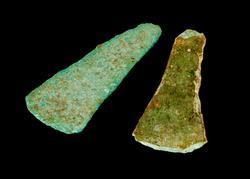 Nevern - An Early Bronze Age hoard, which is thought to have been buried around 2000BC (4,000 years ago) has been declared treasure by H.M. Deputy Coroner for Pembrokeshire. The hoard of two early bronze flat axes, was discovered in the Community of Nevern, Pembrokeshire during early August 2011. The axes were found less than 3 metres apart while the finders were metal detecting in a field under pasture. One axe, of simple and slender form, is a very early bronze form of late Migdale metalworking tradition. The other, slightly shorter and more flared, has more developed features, including hammered face edges and ‘rain pattern’ decoration from the butt to the blade end. It is an early Developed Flat Axe, known as Aylesford type. Uncertainty remains as to the reason for the burial of two complete axes in this location. It may have been regarded as a special place in the landscape, near to a stream source and looking out towards the sea. This new discovery is also part of a wider observed clustering of single early bronze axes discovered in north west Carmarthenshire and north east Pembrokeshire. Adam Gwilt, Curator of the Bronze Age Collections at Amgueddfa Cymru – National Museum Wales said:“This is an important discovery of early bronze axes for Wales, providing a picture of developing bronze casting expertise around 4,000 years ago. This find-spot, on the northern margins of Mynydd Preseli, sits within a rich and important prehistoric ritual landscape."The hoard adds to the wider picture of the lives of the early metalworking communities here at the beginning of the Bronze Age.”
Nevern - An Early Bronze Age hoard, which is thought to have been buried around 2000BC (4,000 years ago) has been declared treasure by H.M. Deputy Coroner for Pembrokeshire. The hoard of two early bronze flat axes, was discovered in the Community of Nevern, Pembrokeshire during early August 2011. The axes were found less than 3 metres apart while the finders were metal detecting in a field under pasture. One axe, of simple and slender form, is a very early bronze form of late Migdale metalworking tradition. The other, slightly shorter and more flared, has more developed features, including hammered face edges and ‘rain pattern’ decoration from the butt to the blade end. It is an early Developed Flat Axe, known as Aylesford type. Uncertainty remains as to the reason for the burial of two complete axes in this location. It may have been regarded as a special place in the landscape, near to a stream source and looking out towards the sea. This new discovery is also part of a wider observed clustering of single early bronze axes discovered in north west Carmarthenshire and north east Pembrokeshire. Adam Gwilt, Curator of the Bronze Age Collections at Amgueddfa Cymru – National Museum Wales said:“This is an important discovery of early bronze axes for Wales, providing a picture of developing bronze casting expertise around 4,000 years ago. This find-spot, on the northern margins of Mynydd Preseli, sits within a rich and important prehistoric ritual landscape."The hoard adds to the wider picture of the lives of the early metalworking communities here at the beginning of the Bronze Age.”
http://www.newswales.co.uk/index.cfm?section=Tourism&F=1&id=25562
ROYAUME UNI – Kingskerswell - Archaeologists carrying out investigations in advance of the construction of the South Devon Link Road, near Kingskerswell, Devon, have widened their search. The archaeologists, who uncovered the remains of a 2000 year old Roman settlement and a stone-constructed medieval building in December last year, will now be undertaking a further assessment along the rest of the planned route of the new road, to establish archaeological potential. Archaeologists have just discovered another medieval building at Edginswell Lane: pottery found at the site indicates that it dates to the 13th century, while the presence of extensive burnt material and debris within the interior hints that it may have been destroyed by fire around 1750-1800'. It is hoped that the further search will uncover more detail around the medieval building as well as around the Roman settlement site at Aller Cross. The 5.5km dual carriageway, which will provide the long awaited bypass for Kingskerswell, was given full approval by the government in May – work began in October and is due to be completed by December 2015.
http://www.thisissouthdevon.co.uk/Archaeologists-widen-search-South-Devon-Link-Road/story-18314998-detail/story.html#axzz2Mb1sVGx6
JORDANIE – 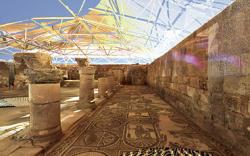 Petra - A recent two-day Cyber-Archaeology expedition at Petra provided new insights on the site’s structural conservation and helped create the next generation of archaeological data presentation. LiDAR scans at the first-century C.E. Temple of the Winged Lions and Petra’s Byzantine church provided the team with a high-resolution view of structural threats to the sites’ preservation. Low altitude balloon photography was used to model the Temple of the Winged Lions and monitor conservation concerns.
Petra - A recent two-day Cyber-Archaeology expedition at Petra provided new insights on the site’s structural conservation and helped create the next generation of archaeological data presentation. LiDAR scans at the first-century C.E. Temple of the Winged Lions and Petra’s Byzantine church provided the team with a high-resolution view of structural threats to the sites’ preservation. Low altitude balloon photography was used to model the Temple of the Winged Lions and monitor conservation concerns.
http://www.biblicalarchaeology.org/daily/news/cyber-archaeology-at-petra/